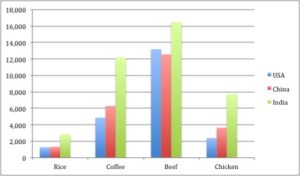
The oft repeated phrase “water is life” speaks to the dependence that humanity has on this essential natural resource. Harnessing the power of water is a clear marker in the development of advanced civilizations- from the earliest example of irrigation technology in Mesopotamia six thousand years ago, to the building of every major European city within close proximity to either a river or a large body of water. The ancient proclamation “as above so below”, which time and again has been used to show the parallel between atoms and galaxies, can also be applied to this natural resource: both the earth and the human body is made up of about two-thirds water. It is, in fact, so essential to human survival that though a person can go without food for more than 21 days (as Ghandi proved during his hunger strike), he cannot go longer than four days without a drink of good ol’ H2O.

Though the world is made up mostly of water, only a small fraction is potable: a mere 2.5%. From that sliver, a still smaller slice is available to humans from surface sources (lakes and rivers) and underground wells. The majority of drinkable water is either trapped in glaciers or seeped into the earth, making it inaccessible for consumption. That is not taking into account the pressing concern of “gray water”: water that would otherwise be suitable for consumption if not for the fact that it has been polluted. The planet naturally filters gray water through the water cycle -evaporation, cloud formation, rainfall- but the pollution is occurring at such a rate as to easily outpace the natural patient effort of the planet.
This presents a dilemma as the population continues to grow. In 1995, Vice President of the World Bank Dr. Ismail Serageldin famously warned, “The wars of this century have been over oil, and the wars of the next century will be over water, unless we change the way we manage water.” In the past 60 years, 4.7 billion people were added to the planet- that’s 4.7 billion thirsty mouths. By the year 2050, it’s estimated that the demand for water will increase by 55%. Water, much like matter, cannot be “created nor destroyed”.* The water on the planet today was present in the same quantity 4.6 billion years ago.
For the conscientious consumer, the concept of virtual water is a relevant consideration. Virtual water refers to the fact that for every product that can be consumed, there exists a water footprint. A single egg, for example, takes a whopping 53 gallons of water to produce. This takes into account all the water that is needed throughout the entire production cycle, from farm to table: the water needed to grow the crops that feed the livestock, create and utilize machinery, transport the product, and so on.

Furthermore, not all eggs are created equal. Certain regions and methods of production have a lower virtual water impact. Generally speaking, consumables produced in the United States tend to more efficiently use water resources. However, it is important to take things on a case-by-case basis. For example, beef (one of the biggest offenders in terms of virtual water usage, with a single hamburger patty requiring over 600 gallons on average) is three times more efficiently produced in the United States than in Mexico. On the other hand, poultry lovers are better off going south of the border for their chicken wings, as Mexico produces chicken meat more efficiently than the US.
Though the task confronting the world may seem daunting, individuals are more empowered than ever before. They have access to vast resources of information. Consumers can create an impact by the choices they make, the products they consume, and the businesses they patronize. And if all the talk of rising global temperatures and holes in the ozone appear to support the case for hopelessness, it is worth remembering that the planet has a natural tendency to repair itself, to heal the wounds that it has sustained. The key is to, as Bruce Lee once said, “be like water” and go with the flow.
____________________________________________
*In theory, scientists can create water by merging two hydrogen atoms and one oxygen atom. However, the process is highly unstable as it would require a controlled explosion to cause the electrons to bond. History buffs will recall the hydrogen-filled Hindenburg zeppelin, which in 1937 crashed in New Jersey after completing its first trans-Atlantic voyage from Frankfurt, Germany. Static electricity- or sabotage- and atmospheric oxygen caused the iconic blimp to go up in flames, while simultaneously producing a ton of water.



